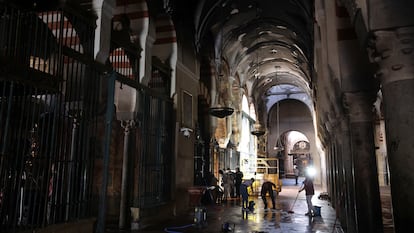The Mosque of Córdoba, a witness to history that must be protected

A didactic exposition of ideas, conjectures, or hypotheses based on verified current events—not necessarily those of the day—that are reflected in the text itself. It excludes value judgments and is closer to the opinion genre, but differs from it in that it does not judge or predict, but only formulates hypotheses, offers reasoned explanations, and connects disparate data.

The afternoon of August 8, 2025, will be remembered for the fire that broke out at the Mosque-Cathedral of Córdoba . When it hit the media and social media, we couldn't even imagine the possibility of the destruction, even partial, of the Mosque of Córdoba. The fire at Notre Dame Cathedral in Paris was too recent for us all to tremble. Fortunately, it was saved. Everyone knows the value of this building, protected by UNESCO as a World Heritage Site in 1984 and one of the most visited in Spain, but it doesn't hurt to remember it. It is the oldest and best-preserved mosque in the world, an honor shared only with the Umayyad Mosque in Damascus and the Dome of the Rock in Jerusalem. However, unlike Damascus, which suffered a devastating fire in 1893, the Mosque of Cordoba preserves intact a large part of its structure, built between the 8th and 10th centuries. It is true that a cathedral was built within it, and that over the centuries some changes have been made and some things have been lost, but the essence of the great mosque of what was the capital of the Umayyad Caliphate of al-Andalus remains intact.
The building is the best testimony to the first centuries of Islamic presence in the Iberian Peninsula. It was built by the first Umayyad emir, Abd al-Rahman I, around 785 and underwent three major expansions. The most artistically spectacular was that undertaken by Caliph al-Hakam II between 961 and 976, when the beautiful domes were erected and it was decorated with golden mosaics, features that make it absolutely unique and that inspire admiration among visitors today.
Friday's fire affected the part added at the end of the 10th century, better known as Almanzor's extension. Fortunately, the nave where it occurred, the last one next to the eastern façade, is divided into chapels, as was also the case on the western side after its conversion into a cathedral in 1236. Likewise, in these naves, the original wooden roof was replaced with vaults with skylights in the 18th century, vaults that have been blackened by smoke. I don't know whether these circumstances aided the firefighters' work or not, but it is a relief that the flames didn't spread much further. In the arcades of this part, you can see the skill of the Umayyad architects, who added eight naves to the original 11-nave mosque. If you look closely as you walk through them, you will see how the width of the arches changes to adapt to the space they had to cover parallel to the older naves. Added to this are the facades facing the street, decorated with inscriptions of Quranic significance. Although less luxurious, this entire eastern section of the building, partially affected by the fire, is of great architectural value.
At a time when we are witnessing the massive destruction of a territory like Gaza , where the ongoing genocide prevents us from even thinking about the destroyed Palestinian heritage, a time when, in some places on our Peninsula, the celebration of Muslim festivals is being persecuted, it may be encouraging to contemplate the mobilization and expressions of extreme concern that the burning of our finest mosque has sparked. The loss of heritage means the loss of historical memory, of a part of the identity of peoples, which is why its destruction is such a powerful weapon (the Palestinian people can attest to this).
Today we congratulate ourselves on the prevention and action plans protecting the Mosque of Córdoba, and all the improvements and new measures implemented from now on are more than welcome. The Córdoba firefighters managed to extinguish a fire that would have been devastating with minimal damage. This mobilization made me think of another moment in the building's history, when the Córdoba Council, in 1523, tried to prevent construction of the new cathedral because they believed that "what is falling apart is of a quality that cannot be restored to the goodness and perfection in which it is built." And here it remains, standing, the most beautiful mosque of our Islamic past.
Susana Calvo Capilla is a professor of art history at the Complutense University of Madrid and a specialist in Islamic art.
EL PAÍS


%3Aformat(jpg)%3Aquality(99)%3Awatermark(f.elconfidencial.com%2Ffile%2Fbae%2Feea%2Ffde%2Fbaeeeafde1b3229287b0c008f7602058.png%2C0%2C275%2C1)%2Ff.elconfidencial.com%2Foriginal%2F5d1%2F9a1%2F007%2F5d19a1007aa2dc7fc503fabd38bba65e.jpg&w=3840&q=100)
%3Aformat(jpg)%3Aquality(99)%3Awatermark(f.elconfidencial.com%2Ffile%2Fbae%2Feea%2Ffde%2Fbaeeeafde1b3229287b0c008f7602058.png%2C0%2C275%2C1)%2Ff.elconfidencial.com%2Foriginal%2Fcf4%2F399%2F9b1%2Fcf43999b1150521c66b126806b23fab1.jpg&w=3840&q=100)

